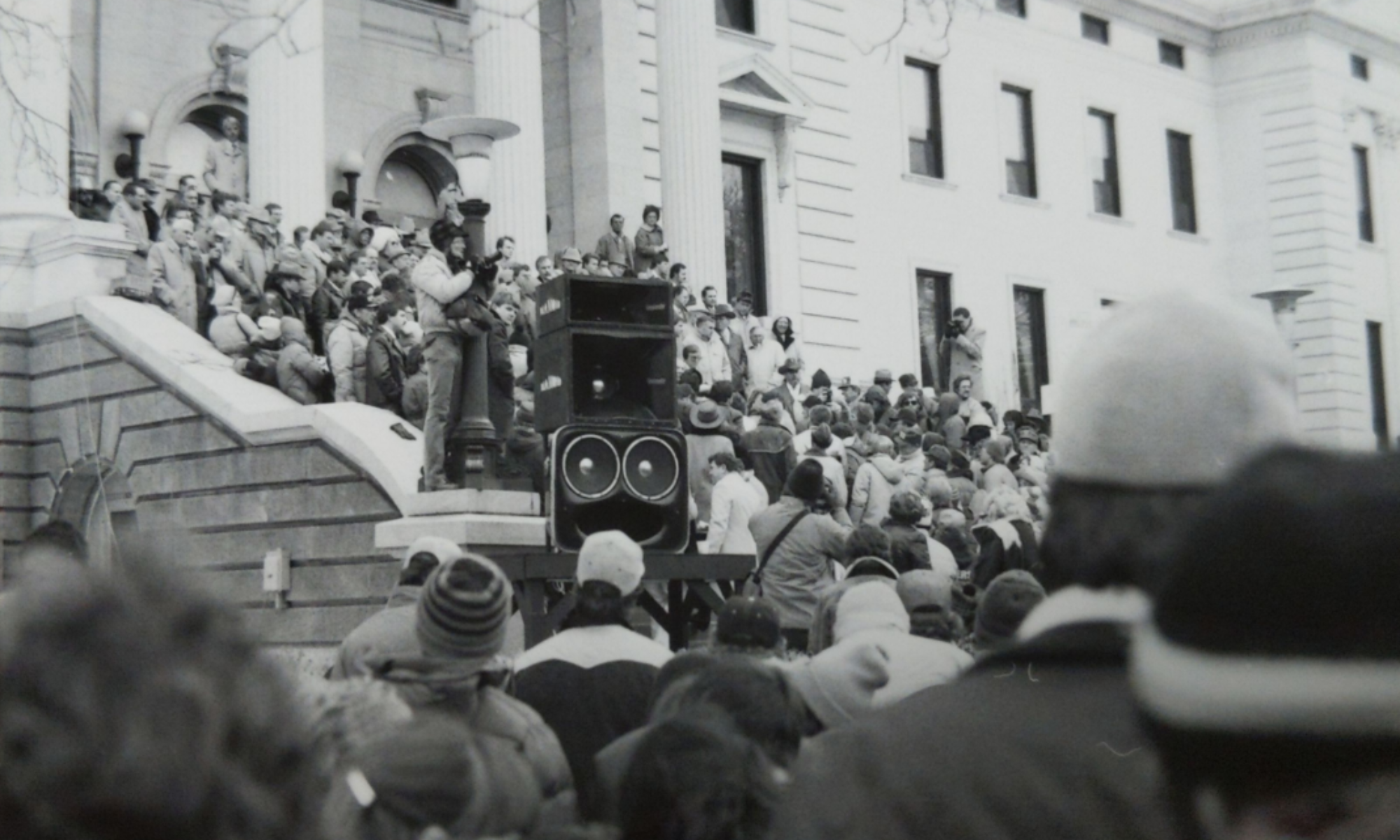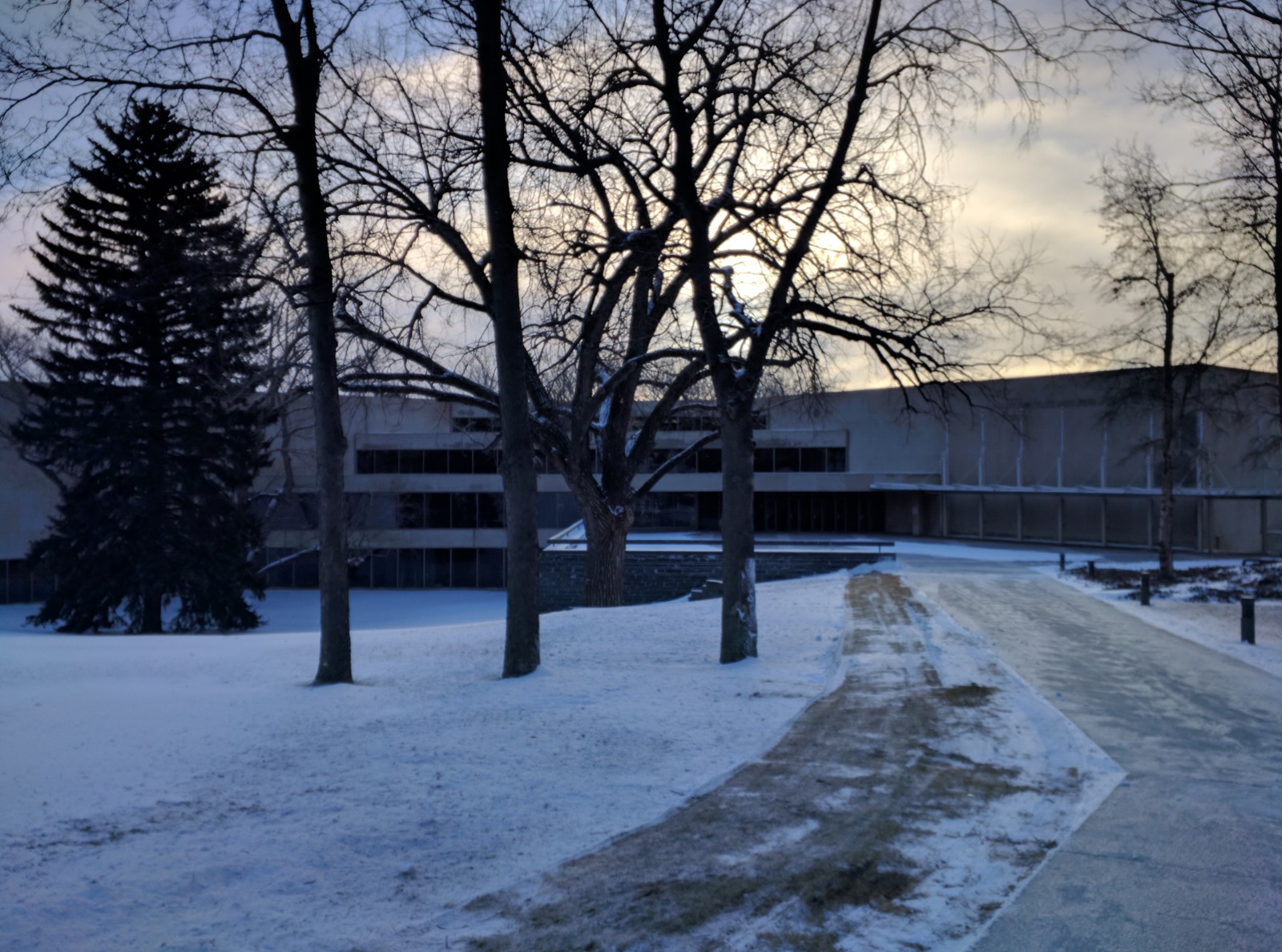I was supposed to take a trip to Bismarck this summer after my journey through Grand Forks into Canada, but travel and driving fatigue led me to skip it in favor of a week in River Falls.
My punishment was leaving for Bismarck at 3:15am on January 2.
This wasn’t a planned trip, but in my efforts to get all the leg work done on at least the second chapter of my dissertation (which I’ve promised Fr. Avella by May 2018), I could not keep putting a trip to the North Dakota capital off any longer.
North Dakota’s contribution to my dissertation will be both similar to other states’ and yet very, very different. For those of you who don’t remember my trip to Grand Forks, remember that in North Dakota the Democratic Party is actually the Democratic-Nonpartisan League, the product of a 1956 merger between the Democratic Party and the more liberal “Insurgents” (compared to the conservative, anti-farmers’ union “Old Guard”) within the Nonpartisan League.
In a manner very similar to the other four Upper Midwestern states, North Dakota experienced a Republican takeover in 1978 and 1980. Despite already controlling the Legislature, under party chair John Sellie the Republicans took a net gain of 23 legislative seats in the 1978 election, then swept 11 of the 13 statewide races (with only two incumbents seeking reelection) in 1980. One of those wins was Attorney General Allen I. Olson’s 53.6-46.4% victory over two-term incumbent D-NPL Governor Arthur A. Link, ending twenty years of D-NPL control of the governorship.
This trip, effectively, was to explore the dynamics surrounding the 1978-80 elections, Republican strategies for winning the elections, and D-NPL responses to the Republican landslide. Additionally, thanks to Dr. Michael Lansing, the expert on the Nonpartisan League (who I cited back in the Grand Forks piece), I was tasked with exploring the transition in political culture from the Quentin Burdick-era D-NPL to the Kent Conrad/Byron Dorgan era of the D-NPL, learning about Agriculture Commissioner Sarah Vogel and, where possible, Tax Commissioner-turned-Attorney General-turned-U.S. Senator Heidi Heitkamp.
The Research
Collections
North Dakota Republican Party Records, 1956-1982; A347 (33%)
North Dakota Democratic-Nonpartisan League, 1906-2009; MSS 11078 (67%)
Findings
(There are no pictures in this section because State Historical Society of North Dakota rules do not permit photography of collections.)
The “Republican Landslide” in North Dakota was not as ideologically-motivated as other states. We’ve talked about pro-life flyering in Minnesota and “national liberalism” in South Dakota, Reaganomics in western Wisconsin and gender politics in Iowa. But in North Dakota, the prevailing message among many Republicans was as simple as “It’s time for a change.” While the North Dakota GOP was racked with internal conflict over the aggressive leadership tactics of John Sellie, who got in public disagreements with Attorney General Robert Wefald over how to lead the party in the election, Olson instead ran a pragmatic campaign highlighting issues on which he would promote development.[1] In fact, one North Dakota strategist argued that “in our [issue] areas, Olson does better against Link than he does in straight head to head votes against the Governor. These are: 1. Developing economic opportunity for North Dakotas, 2. Coming up with new ideas for the state, 3. Solving the water, energy and resources problems, 4. Speaking out for North Dakota.”[2]
In North Dakota, “Western” Republicans vs. “Midwestern” Democrats? I’m not suggesting that these are one-to-one matches. But when North Dakota Republicans planned to beat a Democratic incumbent (Link), they looked west: “Experience in the Evans campaigns in Washington, Paul Laxalt in Nevada, and Governor Love in Colorado confirm that it takes a considerable period of time for this to gestate but when it does the challenger must be ready to offer positive programs and positive solutions to problems that are on people’s minds.”[3] Given the widespread successes of Republicans in the Upper Midwest, I find it curious the North Dakota GOP looked west, not east, for their example.
A PROGRESSIVE POPULIST! Kent Conrad described himself as exactly that in the D-NPL state convention program:
“Conrad has brought millions of dollars into the state’s coffers, proving that progressives can keep state budgets healthy without taxing working- and middle-class folks to death. In 1981 and ’82, the populist taxman doubled corporate tax assessments, more than 75 percent of this bounty coming from his aggressive audits of out-of-state companies. Conrad combines his prairie populism with a reputation as a superb administrator, a man who pinches a penny until Lincoln screams.”[4]
That…is incredibly important. Conrad was perhaps the most prominent figure in state-level politics during the Olson Administration (compared to national figures like Sen. Quentin Burdick and Rep. Byron Dorgan), becoming the face of North Dakota D-NPLers’ fighting for average constituents against corporations and predatory utilities like the Burlington Northern Railroad. But to hear him use a phrase at the same time that Tom Harkin was running for Senate in Iowa on a platform of “progressive populism” allows me to build the argument that this is a regional phenomenon, both in terms of policy and nomenclature.
Remembering their NPL roots. Much of the D-NPL resurgence (taking the State House in the 1982 elections, retaking the governorship in 1984, taking the Senate for the first time ever in 1986) was done with a nod to the party’s Nonpartisan League heritage. A group of D-NPL “Old Turks” who returned to the North Dakota Legislature in the 1982 election, including S.F. “Buckshot” Hoffner (House 1963-1966, 1969-1972, Senate 1973-1980), who had helped lead the Insurgents into the Democratic column in 1956.[5] They brought these political approaches back with them in the early 1980s, but in my notes I’d marked down that it seemed concerning that there were no young politicians (seemingly beside Conrad) espousing these same positions.
Luckily, Sarah Vogel’s name popped up just in time. An lawyer who returned to North Dakota after spending time in Washington, D.C., Vogel represented family farmers and won an injunction against farm foreclosures in Coleman v. Block. The daughter of NPLer and North Dakota Supreme Court Justice Robert Vogel, Sarah Vogel became Assistant Attorney General to D-NPLer Nick Spaeth in 1985, then successfully ran for Agriculture Commissioner in 1988. In that role, Vogel brought back some hallmarks of the NPL, including promoting agricultural cooperatives in the North Dakota Marketplace program and fighting what she considered needless foreign involvement in GATT and NAFTA.[6] Cooperative economics, old-boy political machinery, and foreign isolationism: sounds like The Goat That Couldn’t Be Got to me!
There’s a lot more to talk about here, from the role women played in the D-NPL during the 1980s (I haven’t forgotten about Ruth Meiers or Heidi Heitkamp, to say nothing of Rep. Janet Wentz’s crusade to recognize marital rape as a real crisis[6]) to the crippling effects of the 1992 D-NPL gubernatorial primary, but we’ll get to it some other time.
The City
The Lodging
An Airbnb in neighboring Lincoln. I recommend DJ’s Tavern for some good pizza and cheap drinks, but otherwise it’s a little bedroom community where the residents appeared to take the 15 MPH speed limit on the neighborhood streets very seriously. Derek and Sophie, my hosts, had a beautiful home and gave me full use of their basement. That’s about as good as it gets for just a “private room.”
The Sightseeing
I was pretty tired for most of this trip; recovering from these 3:15am departure times is getting tougher and tougher, especially in the winter months. As such (and given that it was dark by 5pm), I didn’t get a ton of sightseeing in beyond a tour of the Capitol and a few breweries.
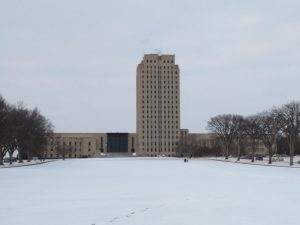
The North Dakota Capitol is stunningly different from the other four I’ve visited, and in a way is a unique reflection of the political culture of the region. Rather than the stately white domes of St. Paul and Madison, the dark-hued dome and sprawling grounds of Pierre, or the gilded dome of Des Moines, the North Dakota Capitol is a 21-story stone tower reconstructed during the Great Depression. It rises above the city (and reminded me of the Pitt Cathedral of Learning) and evokes much more of the harsh reality of life on the Northern Plains. But, in the typically cheery way I love about the Upper Midwest (the gas station attendant in West Fargo greeted me Tuesday morning with “Oh, it was negative thirteen this time yesterday; it’s only negative eleven today!”), North Dakotans make the best of it: in 2007 they set a Guinness World Record for most simultaneously snow angels made, on the mall leading up to the Capitol.
The Beer!
I’m excited to give an update on beer. It’s been a while! At the recommendation of my sister’s fiance Troy, I started at Laughing Sun Brewery in downtown Bismarck. Nestled next door to Fireflour cafe (where patrons to Laughing Sun are encouraged to pick up dinner to bring into the brewery), Laughing Sun is a darker, cozier brewery with long booths and a curved bar.
The 12-seat bar was completely full when I walked in, leading me to order a Black Shox Porter and sit on my laptop at a table by myself. Given that all the patrons appeared to be in the Mug Club, I felt like I’d walked into a bit of a private thing at 4:45pm.  I’d definitely head back and give it another try, as the Black Shox wasn’t my favorite porter ever (sweet, but not the chocolate flavor I’d expected) and the Feast of Sultan IPA was a pretty standard offering. I’d love to come back after 7pm for their nightly live music–that would likely make the brewery much more inviting.
I’d definitely head back and give it another try, as the Black Shox wasn’t my favorite porter ever (sweet, but not the chocolate flavor I’d expected) and the Feast of Sultan IPA was a pretty standard offering. I’d love to come back after 7pm for their nightly live music–that would likely make the brewery much more inviting.
Wednesday night I went hunting for another place to pick up a pint, and that led me to seek out Bird Dog Brewing, across the Missouri River in Mandan. Lo and behold! Bird Dog isn’t an actual brick-and-mortar brewery, but rather a brewer operating out of a rented space in a drive-up liquor store and bar on “the Strip” in downtown Mandan.
I hope Bird Dog’s eventually able to move into a space all its own, because the beers were a nice variation on the standard small brewery offerings! I started with the Bourbon Porter at the recommendation of the bartender/store manager. It was much lighter than I expected for a bourbon porter, but had quite the bourbon kick! It was a little tough to parse the bourbon and porter flavors independently, but I would definitely try it again. I followed that up with the Short Haired IPA, which was, again, a perfectly drinkable IPA, but which I regretted choosing over the Belgian Tripel on tap. Not many Belgian Tripels in North Dakota, Cory; you have to try that when you can!
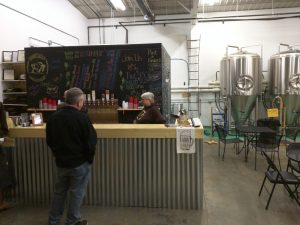
Both Laughing Sun and Bird Dog were fine, but if you can only visit one, it’s well worth rearranging your schedule for the limited hours and smaller space of Buffalo Commons Brewery, just off the Bismarck Expressway on the Mandan side of the Missouri.
It was a blast. You walk into a little guest room where they ask you to sign the guestbook, then into an open, warehouse-style taproom that’s really just a wood bar lined with corrugated metal and framed by a chalkboard paint-covered cooler. Tending bar were Linda and Ted Hoffman, the owners, who graciously humored my inane questions and explained the history of the brewery and their own 7-brewery crawl on a fall Sunday in Minneapolis. It was worth it for the conversation alone, but I stayed for the charm of the place: because they didn’t want to upgrade their liquor license to include a three-sink bar, they pour their beer in solo cups! How can you not love drinking a five year-old brewery’s quality craft beer out of a red solo cup? Eat your heart out, Toby Keith.
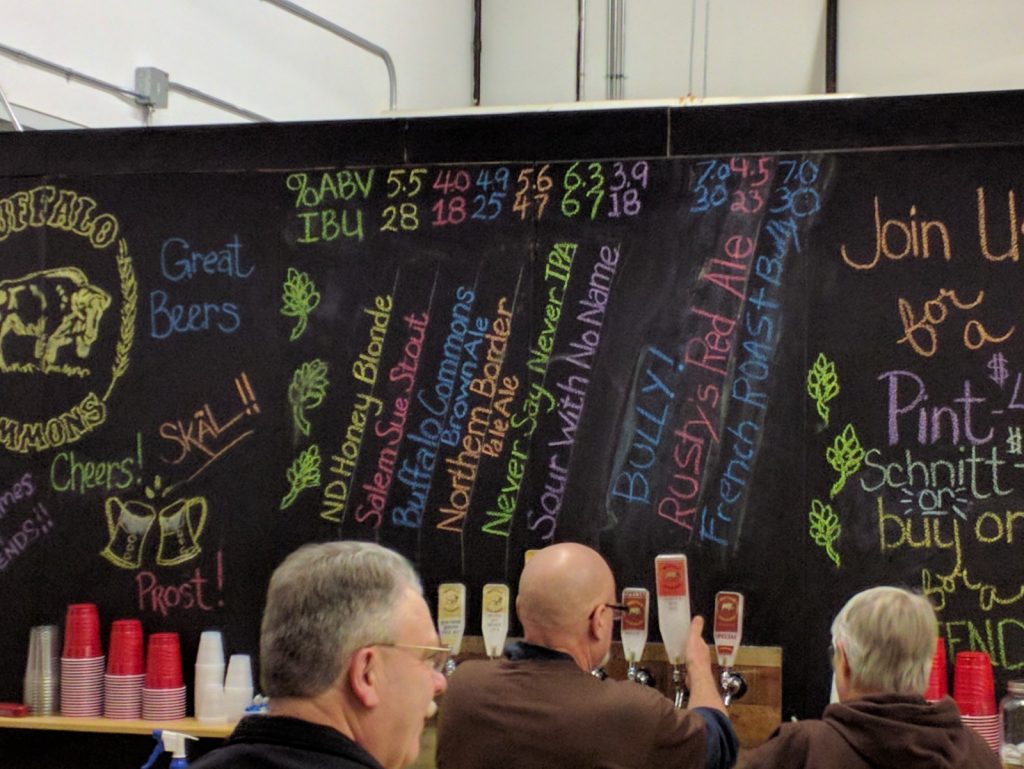

Linda sold me on the “premium” flight of 8 small taster plastic cups–you can see the various styles in the pictures. I am already over 2,000 words on this post and don’t want to bore you further, but I’d recommend my two favorites, the Sour and the French Roast Bully, a porter that was all hopped up with good French roast coffee beans (instead of the normal, awesomely-Teddy Roosevelt-themed Bully! porter). Really, though, they were all amazing. The Salem Sue Stout was one of the roastiest stouts I’ve ever tried, and I’d come back for that alone, even if it is just 4.0%. The ND Honey Blonde reminded me of Bill of Rights’ Honey Basil Ale (minus the basil spiciness, obviously), and the Northern Border Pale Ale had a maltier body than expected, which was a nice respite from the juicier pales I’ve sampled lately.
Plan a trip to Buffalo Commons ahead of time, though: They’re only open 5-9pm Thursday/Friday and 2-8pm on Saturday. It apparently gets nice and busy when the weather gets pleasant and the big garage doors open, and I can’t blame anyone. By far my favorite brewery in North Dakota to date, and I can’t wait to crack into my growler of French Roast Bully.
What’s Next?
I’ve done some trips to Moorhead, Des Moines, and Iowa City in the last month, and I will try to get posts about those up, along with a map of all the places I’ve been since I started this barnstorming adventure in May 2017. If you see me, make me feel bad about not posting more often!
Past Trips
Pierre
Iowa City
Bloomington
St. Paul, St. Cloud
Menomonie
Milwaukee
Iron Range, Lake Vermilion Edition
Grand Forks
River Falls
Iron Range, Biwabik Edition
[1] John Sellie to District Chairmen, “Letter from Bob Wefald, District 47 Chairman,” c. June 1977. Collection of Manuscripts, State Historical Society of North Dakota, Bismarck, ND: North Dakota Republican Party Records, 1956-1982 (A347), Box 3, Folder 20. [2] Gary Hendricks, “Political Campaign Plan for Allen I. Olson, Candidate for Governor of North Dakota,” June 1980, 2. Collection of Manuscripts, State Historical Society of North Dakota, Bismarck, ND: North Dakota Republican Party Records, 1956-1982 (A347), Box 5, Folder 11. [3] Ibid., 4. [4] “Victory ’84,” North Dakota Democratic-Nonpartisan League State Convention, Minot, North Dakota, April 13-15, 1984, 22. Collection of Manuscripts, State Historical Society of North Dakota, Bismarck, ND: North Dakota Democratic-NPL Party Records, 1906-2009 (MSS 11078). Box 2, Folder 10. [5] Bob Jansen, “’Old Turks’ Bring Valuable Experience,” in “The 1983 North Dakota Legislature,” The Bismarck Tribune, January 2, 1983, 17L. North Dakota Democratic-NPL Party Records, 1906-2009 (MSS 11078). Box 2, Folder 9. [6] Reed Karaim, “The Farmers’ Firebrand,” Rural Electrification, March 1995, 20-23. North Dakota Democratic-NPL Party Records, 1906-2009 (MSS 11078). Box 3, Folder 18. [7] “Good ol’ boy thinking is fading in N.D. Legislature,” Associated Press reprinted in The Dickinson Press, March 19, 1989, 8. North Dakota Democratic-NPL Party Records, 1906-2009 (MSS 11078). Box 3, Folder 1.
